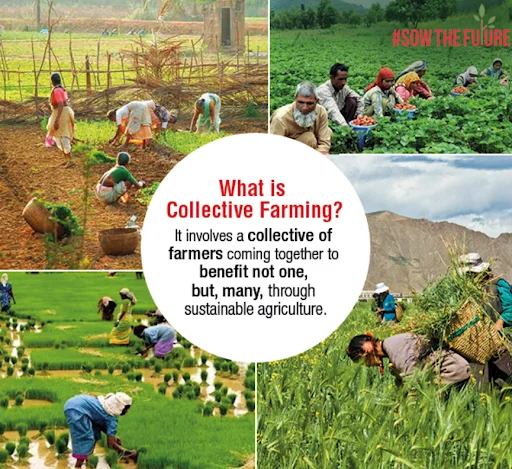Introduction
- India’s agricultural landscape presents a story of sharp contrasts.
- While large landowners flourish with abundant access to resources and capital, small and marginal farmers face immense challenges, often struggling to survive on fragmented land.
- These farmers find themselves trapped in a cycle of shrinking landholdings, limited resources, and exploitation by moneylenders.
What is Collective Farming?
- Collective farming refers to a system where farmers come together to collectively own, manage, and operate their land. This model combines small, fragmented landholdings into larger, more efficient agricultural units.
- The aim is to increase productivity and foster sustainable agricultural practices, while also empowering farmers who might struggle on their own due to limited resources and small land sizes.
- Collective farming can take two primary forms:
-
- Agricultural Cooperatives: These are farmer-owned organizations where the members share the land, resources, and profits from agricultural activities.
- State Farms: These farms are owned and managed by the government, often on a larger scale, aimed at benefiting the community and providing economic stability.

The Need for Collective Farming in India
- India’s agricultural sector is facing numerous challenges, primarily because of land fragmentation.
- According to the 2015-16 agricultural census, the average size of a landholding in India is just 1.08 hectares, which is insufficient for sustainable farming.
- Small land plots and the gradual reduction in farm size due to inheritance practices make it difficult for farmers to earn a livelihood.
Read also: India-Afghanistan Relations | Key Insights for UPSC Preparation
Challenges Faced by Small Farmers
- Fragmented Land: Land inheritance systems have made farms progressively smaller over generations, leaving farmers with insufficient space to generate income. According to the National Sample Survey Organization (NSSO) data, over 85% of farmers in India own less than 2 hectares of land, which severely limits their productivity.
- Limited Resources: Many small farmers lack access to essential resources such as quality seeds, irrigation, and modern farming techniques, further hampering their productivity. A study by the Food and Agriculture Organization (FAO) estimates that more than 60% of farmers in India lack access to reliable irrigation systems, which further compounds their problems during dry seasons.
- Debt Traps: Without access to formal financial services, many small farmers turn to moneylenders who charge high interest rates, leading to a cycle of debt that deepens the financial strain. According to the National Bank for Agriculture and Rural Development (NABARD), nearly 50% of rural households are in debt, often due to these exploitative practices.
Key Features of Collective Farming
- Pooling of Land: Farmers combine their individual plots into one large farming unit. While they still retain ownership of their land, pooling allows for more efficient use of land and resources, leading to better productivity and profitability. For instance, the Punjab Agricultural University reports that when landholdings are pooled in cooperative models, per-acre yield increases by 20-30%, primarily due to improved irrigation and mechanization.
- Collaboration with Social Entrepreneurs: In collective farming, social entrepreneurs play a critical role. They provide the initial investment, water resources, high-quality seeds, and access to markets. These entrepreneurs also introduce agricultural experts who help farmers adopt modern, sustainable farming practices. For example, Selco India, a social enterprise focused on renewable energy, has collaborated with farmers in rural Karnataka to provide solar-powered irrigation systems, reducing farmers’ dependency on unreliable and expensive power sources. This not only improves water availability for farming but also enables farmers to adopt more efficient and environmentally friendly farming practices.
- Natural Farming Practices: One of the key features of collective farming is its emphasis on sustainability. Farmers are trained to use organic methods to improve soil health, such as making fertilizers from cow dung, cow urine, jaggery, lentil flour, and virgin soil. This reduces reliance on chemical inputs, lowers environmental impact, and supports long-term agricultural sustainability. For example, in Andhra Pradesh, the Zero Budget Natural Farming (ZBNF) movement, which promotes the use of such natural inputs, has helped over 1.5 million farmers improve soil fertility and crop yield without relying on expensive chemical fertilizers.
- Revenue Distribution: The income generated from farming is shared among the participating farmers. They receive daily wages for their labor and a share of the profits based on the amount of land they contribute. This ensures fair compensation for all and fosters a sense of community cooperation. For example, in Gujarat’s Kheda Farmers’ Cooperative, members receive daily wages during the farming season, and the profits from the sale of crops are distributed according to the acreage each farmer has contributed. This system ensures that every farmer benefits fairly from collective efforts.
Benefits of Collective Farming
- Economic Stability: Collective farming offers farmers immediate income through wages and long-term financial benefits through profit-sharing. This dual source of income helps farmers become more financially secure. A study by the Indian Council of Agricultural Research (ICAR) showed that farmers in collective farming units had 40% higher income compared to their counterparts in traditional farming setups.
- Sustainability: The use of natural farming techniques ensures that farming practices remain environmentally friendly and sustainable. This not only improves soil health but also reduces dependency on harmful chemicals, creating a healthier ecosystem for future generations. According to the Indian Organic Farming Association (IOFA), natural farming methods help conserve over 40% more water than conventional farming methods, which is crucial in India’s increasingly water-scarce regions.
- Social Empowerment: By coming together as a collective, farmers gain social empowerment. They have more bargaining power in the marketplace, reducing their dependence on moneylenders and giving them a stronger voice in local and national agricultural policies. In Madhya Pradesh, farmers participating in collective farming have been able to increase their bargaining power, leading to better prices for their produce.
- Prevention of Land Fragmentation: Collective farming helps prevent further land fragmentation by pooling resources. This keeps the land viable for agricultural activities in the long term and ensures the sustainability of the farming unit. In states like Haryana, where landholdings are among the smallest in the country, collective farming has helped prevent the further division of land due to inheritance and allows future generations to continue farming the land sustainably.
- Improved Market Access: By working collectively, farmers gain better access to markets, reducing the influence of middlemen. This allows them to sell their produce at better prices and receive a higher share of the profits. A study conducted by NABARD highlighted that collective farming units that pooled resources were able to access larger markets and sell produce directly to retailers, cutting out middlemen and ensuring better profit margins.
See more: Minimum Support Price (MSP) – Key for UPSC Preparation
Steps to Promote Collective Farming in India
- Financial Incentives: To encourage collective farming, the government can offer subsidies for natural farming inputs, such as organic fertilizers and water-efficient irrigation systems. Additionally, tax benefits for social entrepreneurs investing in agriculture could further promote this model. The Pradhan Mantri Krishi Sinchayee Yojana (PMKSY), launched in 2015, has already provided irrigation support to farmers; expanding this to include collective farming units could greatly enhance its impact.
- Agricultural Mechanization: By developing apps or platforms to aggregate agricultural mechanization inputs on a rental basis, small farmers can access modern farming equipment without the high upfront costs. This makes farming more efficient and reduces labor costs. In Tamil Nadu, apps like AgriApp have already helped farmers access mechanized services at affordable prices.
- Simplified Financing: Financial institutions should simplify the procedures for availing loans, especially for farmers adopting collective farming. Kisan Credit Cards (KCC) could be made more accessible, and the documentation process for term loans should be reduced. Training bank staff on agricultural loan products would also improve access to financing. Financial products like Kisan Credit Cards (KCC) should be expanded to support collective farming initiatives. According to a World Bank report, simplifying documentation and loan approval processes could increase loan disbursement to small and marginal farmers by 30%.
- Capacity Building for Farmers: To ensure the success of collective farming, farmers need to be trained in both traditional agricultural knowledge and modern farming techniques. Agricultural experts, NGOs, and government agencies should collaborate to provide training that emphasizes sustainable and efficient farming practices. For example, Gujarat’s Krishi Vigyan Kendras (KVK) have been instrumental in providing farmers with both technical training and financial literacy.

